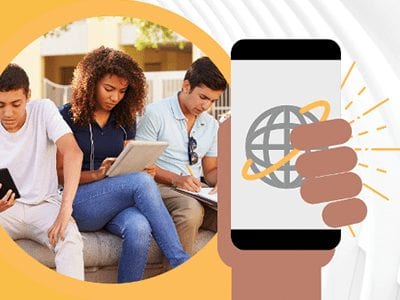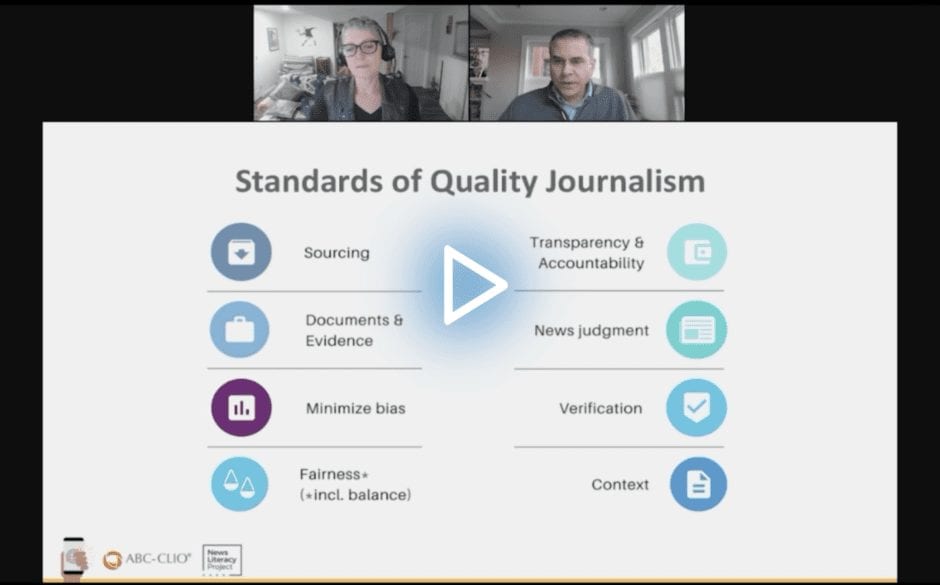Teaching with the News in a Time of Challenge and Change
By Eileen Belastock
Between the recent presidential election, COVID-19, and racial unrest, our students are barraged with 24/7 access to news and media that can be real, fake, or altered. According to the presenters in a recent edWebinar, sponsored by ABC-CLIO, the relationship between the terms “news” and “media” are fundamental distinctions that we need to make when working with students in the new era of journalism. Jacquelyn Whiting, Innovation and Technology Specialist for Cooperative Educational Services, and Peter Adams, Senior Vice President of Education for the News Literacy Project, assert that while there are many credentialed journalists, there is also “a world of citizen journalists with mini computers in their pockets.”
As both news and media types of journalists are content creators, the relationship between professional and citizen is significant for us to consider with our students. Students must understand when to recognize trustworthy information and credible, quality journalism. The presenters favor beginning the process of teaching students to identify reliable journalism by ensuring they understand and acknowledge quality journalism standards: sourcing, documents and evidence, minimize bias, fairness, transparency and accountability, news judgment, verification, and context.
While many journalists, both professional and amateur, keep high journalism standards, many content creators are posting, sharing, and writing disinformation. These creators count on three types of bias from their readers: emotional reactions, implicit bias, and propaganda tactics. When the reader has an emotional response to a piece of media, emotional arousal suppresses critical thought. When beliefs and attitudes are triggered, implicit bias can inspire a different reaction and connection to a piece of media. Propaganda tactics rely on emotional responses, getting on the “bandwagon,” and fear.
It is fundamental to teach students the standards of quality journalism to evaluate and grapple with the critical question of what counts as the center and who decides. When introducing a new lesson with the framework for teaching bias, it is imperative to break it down to the five types of news media biases: partisan, demographic, corporate, neutrality, and “big story.” The presenters recommend creating lessons that help students push past all of the biases by identifying the five core set of forms that biases can take: the absence of fairness and balance, framing, tone, story selection, and sourcing.
While social media can play a big part in where our students get their information, it is paramount for educators to design news and media lessons on straight news. The mindset for educators in designing quality lessons about news and media should be that the perception of bias is the beginning and not the end of student inquiry. If a student thinks something is biased, ask them in what ways is it biased, what type of bias are they seeing and how is it expressed, and how could it have been fairer or more accurate? A caution from the presenters is to be wary of students’ cynicism and their assumptions that everything is out to manipulate them in some way. Help students approach identifying biases in a fair-minded sort of skeptical way and avoid the pitfalls of cynicism.
This edWeb broadcast was sponsored by ABC-CLIO.
This article was modified and published by eSchool News.
About the Presenters
Jacquelyn Whiting is the innovation and technology specialist for Cooperative Educational Services (CES) in Trumbull, CT and information literacy editor at School Library Connection. She has a bachelor’s in government studies and studio art from Connecticut College and a master’s in social studies and education from South Connecticut State University. She is also a Google Certified Innovator and Local Activator for Future Design School. Jacquelyn is the co-author of News Literacy: The Keys to Combating Fake News. She presents frequently on human-centered design, student and educator voice, and innovative educational technology practices.
Peter Adams is the News Literacy Project’s senior vice president of education. He began his career as a classroom teacher in the New York City schools through Teach For America. He has also taught in the Chicago public schools, at Roosevelt University and at Chicago City Colleges’ Wilbur Wright campus. Since joining NLP in 2009, he has coordinated classroom and after-school programs, served as Chicago program manager, worked on organizational strategy and developed NLP’s digital program. Peter is a graduate of Indiana University, where he majored in English and African American studies and co-founded an independent monthly student newspaper, and has a master’s degree in the humanities from the University of Chicago.
Join the Community
Real World Literacy is a free professional learning community on edWeb.net where educators can collaborate on ways to help their students develop and refine essential digital and media literacy skills.

Eileen Belastock, CETL is the Director of Technology and Information for Nauset Public Schools, MA, and also works with edWeb.net to write articles on their professional learning edWebinars. You can follow Eileen on Twitter @EileenBelastock.




Comments are closed.